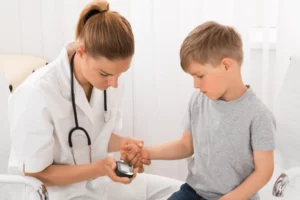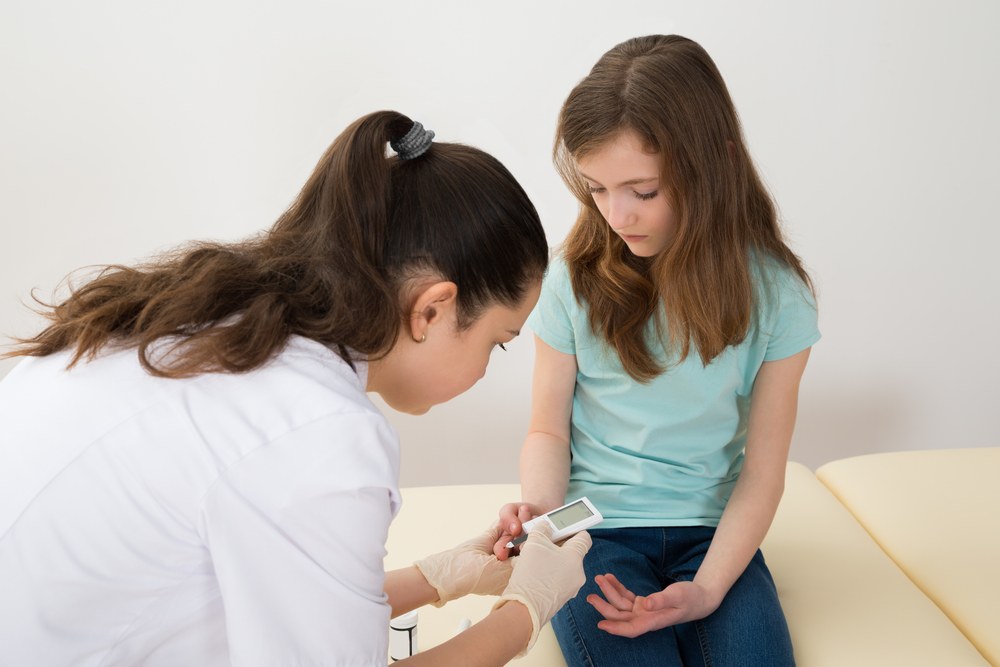Welcome to our informative guide on pediatric hypoglycemia – a condition that requires careful attention and proactive management, especially in the case of young children. As parents and caregivers, understanding the signs, causes, and effective treatment strategies for hypoglycemia in children is crucial for ensuring their well-being. In this blog, we will explore the fundamentals of pediatric hypoglycemia, and delve into actionable insights and pediatric hypoglycemia treatment to navigate and address this condition.
Contents
How Is Pediatric Hypoglycemic Different?
 Pediatric hypoglycemia, or low blood sugar in children, presents unique challenges and considerations compared to hypoglycemia in adults. The physiological and developmental differences between children and adults contribute to distinctions in how hypoglycemia manifests and how it should be managed. Here are some key ways in which pediatric hypoglycemia differs:
Pediatric hypoglycemia, or low blood sugar in children, presents unique challenges and considerations compared to hypoglycemia in adults. The physiological and developmental differences between children and adults contribute to distinctions in how hypoglycemia manifests and how it should be managed. Here are some key ways in which pediatric hypoglycemia differs:
- Rapid Changes in Blood Sugar Levels
Children often experience more rapid fluctuations in blood sugar levels compared to adults. Their smaller body size and faster metabolic rates can lead to quicker shifts in glucose levels, requiring more vigilant monitoring.
- Communication Challenges in Younger Children
Younger children may not be able to communicate their symptoms effectively. They may lack the vocabulary to express how they feel during a hypoglycemic episode. Ultimately, making it crucial for caregivers to be attuned to subtle signs and changes in behavior.
- Varied Causes of Hypoglycemia
While some causes of hypoglycemia in children overlap with adults, such as insulin overdoses or irregular meal patterns, there are pediatric-specific causes. Neonatal hypoglycemia, for instance, can occur in newborns due to factors like maternal diabetes, prematurity, or other metabolic disorders.
- Impact on Neurological Development
Hypoglycemia in pediatric patients can have a more pronounced impact on neurological development. The developing brain is highly sensitive to changes in glucose levels, and recurrent hypoglycemic episodes may contribute to cognitive issues if not promptly addressed.
- Differential Diagnosis Challenges
Pediatric hypoglycemia may be mistakenly attributed to other conditions. Children may exhibit symptoms such as irritability, confusion, or fatigue. This can be misconstrued as normal childhood behavior or unrelated health issues. This makes accurate diagnosis more challenging.
Understanding these differences is crucial for parents, caregivers, and healthcare professionals involved in the care of children with hypoglycemia. Tailoring management strategies to the unique needs of pediatric patients ensures effective and safe treatment while supporting optimal growth and development.
What Is The Immediate Pediatric Hypoglycemia Treatment?
 Immediate pediatric hypoglycemia treatment involves raising the child’s blood sugar levels to a safe range as quickly as possible. The goal is to alleviate symptoms and prevent any potential complications. Here are the recommended steps for immediate pediatric hypoglycemia treatment:
Immediate pediatric hypoglycemia treatment involves raising the child’s blood sugar levels to a safe range as quickly as possible. The goal is to alleviate symptoms and prevent any potential complications. Here are the recommended steps for immediate pediatric hypoglycemia treatment:
Administer Quick-Acting Carbohydrates
Provide a rapid source of glucose to raise blood sugar levels. This can be in the form of 15 grams of fast-acting carbohydrates, such as:
- Glucose gel or tablets
- Fruit juice (about 4 ounces)
- Regular soda (non-diet) – approximately 4 ounces
- Honey (1 tablespoon)
- Hard candies or glucose candies
Make sure to check the product labels for the amount of carbohydrates and administer the appropriate quantity based on the child’s age and weight.
Wait and Reassess
After administering the quick-acting carbohydrates, wait for about 15 minutes and then recheck the child’s blood sugar levels. This allows time for the glucose to be absorbed and for the blood sugar to rise.
Repeat if Necessary
If the blood sugar levels remain below the target range, repeat the administration of quick-acting carbohydrates and continue to monitor the child closely.
Provide a Snack or Meal
Once the blood sugar levels have returned to the target range, offer a snack or meal that includes a combination of carbohydrates, protein, and fat to help sustain blood sugar levels.
Seek Medical Assistance
If the child’s symptoms persist or if blood sugar levels do not respond to initial treatment, seek immediate medical attention. In some cases, a healthcare professional may need to intervene and administer additional treatments, such as intravenous (IV) glucose.
It’s important to note that caregivers should always follow the specific guidelines provided by the child’s healthcare team for managing hypoglycemia. Additionally, it’s crucial to be familiar with the child’s individualized hypoglycemia management plan, including the recommended blood sugar targets and appropriate actions to take in case of low blood sugar.
In emergencies where the child is unconscious or unable to swallow, glucagon may be administered. Glucagon is a hormone that raises blood sugar levels by promoting the release of glucose from the liver. Caregivers should be trained on how to use glucagon and have it readily available if prescribed by the healthcare provider.
What Are Other Strategies In Pediatric Hypoglycemic Treatment?
 In addition to the immediate treatment steps, here are some additional strategies for effective long-term management of pediatric hypoglycemia treatment:
In addition to the immediate treatment steps, here are some additional strategies for effective long-term management of pediatric hypoglycemia treatment:
Individualized Treatment Plans
Work closely with the child’s healthcare team to develop an individualized hypoglycemia management plan. This plan should take into account the child’s age, weight, lifestyle, and specific medical needs.
Continuous Glucose Monitoring (CGM)
Consider using continuous glucose monitoring systems, if suitable for the child’s age and lifestyle. CGM provides real-time information about blood sugar levels, helping caregivers and healthcare professionals make timely adjustments to insulin dosages and dietary plans.
Meal and Snack Planning
Create a consistent and well-balanced meal and snack schedule. Ensure that meals include a combination of carbohydrates, protein, and healthy fats to provide sustained energy and help prevent fluctuations in blood sugar levels.
Education and Empowerment
Educate the child, parents, caregivers, and teachers about the signs and symptoms of hypoglycemia, as well as the appropriate steps to take in case of an emergency. Empowering those involved in the child’s care enhances the overall management of the condition.
Regular Monitoring and Documentation
Keep a detailed log of blood sugar levels, meals, insulin doses, and any episodes of hypoglycemia. Regular monitoring allows healthcare professionals to identify patterns and make necessary adjustments to the child’s diabetes management plan.
Physical Activity Guidelines
Establish guidelines for physical activity that take into account the child’s blood sugar levels before, during, and after exercise. Adjust insulin dosages and carbohydrate intake accordingly to prevent hypoglycemia during periods of increased physical activity.
School Involvement and Communication
Collaborate with school staff to ensure that teachers and other personnel are aware of the child’s condition and know how to respond in case of hypoglycemia. Provide necessary resources, such as emergency contact information and glucagon administration training.
Psychosocial Support
Recognize the emotional impact of managing pediatric hypoglycemia on both the child and the caregivers. Access psychosocial support services to address any concerns or challenges related to the child’s well-being.
Regular Follow-Up Appointments
Schedule regular follow-up appointments with the child’s healthcare team to assess blood sugar control, adjust treatment plans as needed, and address any questions or concerns from the caregivers.
Transitioning to Self-Management
As the child matures, gradually involve them in the self-management of their diabetes under the guidance of healthcare professionals. This transition empowers the child to take an active role in their care as they become more capable of managing their condition independently.
Remember, effective pediatric hypoglycemic treatment involves a holistic and individualized approach that considers the child’s unique needs, lifestyle, and developmental stage. Regular communication with healthcare professionals and a collaborative effort among caregivers, educators, and healthcare providers contribute to successful long-term management.
How Can I Prevent Pediatric Hypoglycemic?
 Preventing pediatric hypoglycemia involves adopting a proactive and comprehensive approach to managing a child’s blood sugar levels. In addition to the treatment and management strategies discussed earlier, here are specific preventive measures to consider:
Preventing pediatric hypoglycemia involves adopting a proactive and comprehensive approach to managing a child’s blood sugar levels. In addition to the treatment and management strategies discussed earlier, here are specific preventive measures to consider:
- Regular Medical Check-ups
Schedule regular check-ups with the child’s healthcare team to monitor blood sugar levels, assess overall health, and make necessary adjustments to the diabetes management plan.
- Hydration Awareness
Ensure the child stays well-hydrated. Dehydration can affect blood sugar concentrations, so encouraging regular water intake is important for overall health and diabetes management.
- Regular Exercise Routine
Encourage a consistent and appropriate exercise routine. Physical activity is crucial for overall health but may require adjustments in insulin dosages and carbohydrate intake to prevent hypoglycemia during and after exercise.
- Balanced Snacks
Incorporate balanced snacks into the child’s routine to provide sustained energy between meals. Avoid overly restricting food intake, as this can lead to an increased risk of hypoglycemia.
- Bedtime Blood Sugar Checks
Consider checking the child’s blood sugar levels before bedtime, especially if there has been a recent increase in physical activity or if the child has experienced hypoglycemia in the past. Adjustments to nighttime insulin dosages or bedtime snacks may be necessary.
- Age-Appropriate Independence
Gradually encourage age-appropriate independence in diabetes self-management. Teach older children how to monitor their blood sugar levels, administer insulin (if needed), and recognize the signs of hypoglycemia.
- Consistent Sleep Patterns
Maintain consistent sleep patterns. Lack of adequate sleep can affect blood sugar control, so ensuring the child gets sufficient and regular sleep is essential for overall well-being.
- Stress Management Techniques
Teach stress management techniques, especially in older children, as stress can impact blood sugar levels. Encourage healthy coping mechanisms and open communication about stressors.
Remember, preventive measures should be individualized to the child’s unique needs and adjusted as they grow and develop. Consistent communication with healthcare professionals, ongoing education, and a supportive environment contribute to the successful prevention of pediatric hypoglycemia.
Conclusion
In conclusion, effective management and prevention of pediatric hypoglycemia demand a comprehensive and individualized approach. By adhering to precise pediatric hypoglycemia treatment protocols, including prompt administration of appropriate carbohydrates during hypoglycemic episodes, continuous glucose monitoring, and regular medical check-ups, caregivers can optimize blood sugar control in children. Emphasizing the importance of tailored meal plans, hydration, and age-appropriate independence fosters a proactive strategy.
The meticulous implementation of preventive measures, including consistent exercise routines, balanced snacks, and stress management, contributes to sustained well-being. Regular communication with healthcare professionals ensures ongoing adjustments to the child’s diabetes management plan, facilitating a proactive and vigilant stance against pediatric hypoglycemia.
Do you want to get rid of diabetes? Join our online diabetes treatment program and reverse Diabetes naturally through lifestyle changes such as a Personalized Diet plan, Exercise, Yoga, dieticians, and health coaches.

